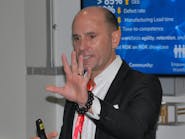Rockwell Automation looks within to transform manufacturing
Every day, manufacturing facilities look to turn their factory-of-the-future dreams into reality, said Bob Buttermore, senior vice president, chief supply chain officer, at Rockwell Automation, who spoke during Automation Fair 2025 in Chicago. “That’s exactly what we’re doing inside of our own operations to enable growth, resilience and margin expansion,” he explained.
Building on the successful automation-to-autonomy transformation of its Singapore facility, Rockwell has turned its attention to its manufacturing plant in Twinsburg, Ohio. “We’re expanding and upgrading the facility next summer to get it to the point where Singapore is,” explained Buttermore. “We started this journey about two years ago in Singapore. It is one of our larger facilities.”
The intent was to reduce production labor costs and mitigate labor shortages. It was a very automated and efficient plant before the transformation, but the enhancements led to a 33% increase in labor efficiency, 60% improvement in time to competency, 25% improvement in quality and 35% reduction in energy, said Buttermore. These improvements led to a 21% annual return on investment.
Those enhancements included Emulate3D to optimize design, which saved time on the front end, OTTO autonomous mobile robots (AMRs) for automating material movement in a lights-out warehouse and FactoryTalk Energy Manager to reduce the facility’s carbon footprint.
Factory-of-the-future AI was used to address challenges such as unplanned downtime, slow defect resolution, limited real-time visibility and crucial single points of failure. “It’s giving our employees the tools to win,” said Buttermore, who noted the challenges were overcome using an AI chatbot for natural-language equipment troubleshooting based on machine manuals, downtime logs and subject-matter expertise; an AI chatbot that traces defects, reducing debug time with instant access to repair data and instructions; an agentic AI to detect component-level defects in real time and automate root-cause analysis; and augmented-reality smart glasses that are integrated into factory systems to boost operator safety and efficiency.
“We had a team in Singapore that was ready,” said Buttermore. “They were the drivers on taking it from automation to autonomy. It was the team there that started it.”
Fusing IT and OT teams
Moving from automation to autonomy requires fusing operating teams to drive more efficient operations. “Bringing IT and domain experts together is reshaping how we operate in the factories,” explained Buttermore. “We’re organizing these fusion teams to drive continuous improvement and AI across the organization. All of this technology is great, but you have to have a disciplined innovation structure.”
Digital expertise coupled with fusion operating teams and disciplined innovation structure translates to talent attraction programs and workforce enablement. “We’re doing the pilot-and-scale model to help us do it right the first time,” explained Buttermore. “Once we feel it’s good and tight, we scale that.”
The biggest challenges aren’t with the technology, but with the people, noted Buttermore. It’s getting them outside of the comfort of what they do today. “It’s getting them to move from a defined role to a more nebulous one,” he said. It’s also having a skilled workforce to implement these technologies. “At Rockwell Automation, our IT team and our OT team are attached at the hip. We have two separate organizations, but there is a team within each organization that is solely dedicated to working with the other organization.
Scaling pilots across the globe
Every implementation of AI is based on the potential for margin expansion. “Everything we build has to have an ROI,” said Buttermore. “We invest in being more competitive. All of that has a runway.”
And that runway includes a long horizon. “We’re talking about how we mobilize a 10-year strategy,” explained Buttermore. “Think about where the big opportunities are to optimize spend. How do we in-source more? We’re in-sourcing plastics and cable assemblies. We’re getting those margins back.”
Rockwell Automation’s plan for a 1 million sq ft greenfield plant in southeastern Wisconsin, for example, will include applications that have been piloted in Singapore or Twinsburg. The Wisconsin facility is expected to come on-line around the end of 2028. “The factory will have the latest and greatest,” said Buttermore. “As new things come out, we’ll integrate that into the new facility from the beginning.”
The Wisconsin plant will integrate the latest in Rockwell’s production technologies, including AI and analytics tools, to increase efficiency and precision, while providing team members with access to advanced tools and training. “I’m excited to see our highly skilled workforce maximize the potential of this site,” said Buttermore. “This investment reflects our confidence in our teams that deliver excellence every day.”
About the Author
Mike Bacidore
Control Design
Mike Bacidore is chief editor of Control Design and has been an integral part of the Endeavor Business Media editorial team since 2007. Previously, he was editorial director at Hughes Communications and a portfolio manager of the human resources and labor law areas at Wolters Kluwer. Bacidore holds a BA from the University of Illinois and an MBA from Lake Forest Graduate School of Management. He is an award-winning columnist, earning multiple regional and national awards from the American Society of Business Publication Editors. He may be reached at [email protected]

